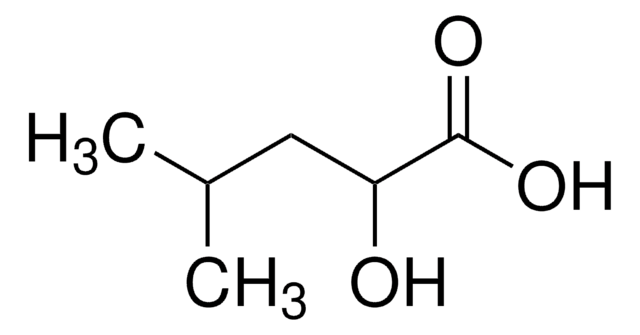H7396
(±)-2-Hydroxyoctanoic acid
Sinonimo/i:
2-Hydroxycaprylic acid, (±)-2-Hydroxycaprylic acid
About This Item
Prodotti consigliati
Stato
powder
Gruppo funzionale
carboxylic acid
Tipo di lipide
saturated FAs
Condizioni di spedizione
ambient
Temperatura di conservazione
room temp
Stringa SMILE
CCCCCCC(O)C(O)=O
InChI
1S/C8H16O3/c1-2-3-4-5-6-7(9)8(10)11/h7,9H,2-6H2,1H3,(H,10,11)
JKRDADVRIYVCCY-UHFFFAOYSA-N
Cerchi prodotti simili? Visita Guida al confronto tra prodotti
Categorie correlate
Azioni biochim/fisiol
Applicazioni
Avvertenze
Warning
Indicazioni di pericolo
Consigli di prudenza
Classi di pericolo
Eye Irrit. 2 - Skin Irrit. 2 - STOT SE 3
Organi bersaglio
Respiratory system
Codice della classe di stoccaggio
11 - Combustible Solids
Classe di pericolosità dell'acqua (WGK)
WGK 3
Punto d’infiammabilità (°F)
Not applicable
Punto d’infiammabilità (°C)
Not applicable
Dispositivi di protezione individuale
dust mask type N95 (US), Eyeshields, Gloves
Scegli una delle versioni più recenti:
Possiedi già questo prodotto?
I documenti relativi ai prodotti acquistati recentemente sono disponibili nell’Archivio dei documenti.
I clienti hanno visto anche
Chromatograms
suitable for GCIl team dei nostri ricercatori vanta grande esperienza in tutte le aree della ricerca quali Life Science, scienza dei materiali, sintesi chimica, cromatografia, discipline analitiche, ecc..
Contatta l'Assistenza Tecnica.







![Poly[(R)-3-hydroxybutyric acid] natural origin](/deepweb/assets/sigmaaldrich/product/structures/129/476/7d1c924b-f644-4889-a2d6-d7a923ce382c/640/7d1c924b-f644-4889-a2d6-d7a923ce382c.png)






